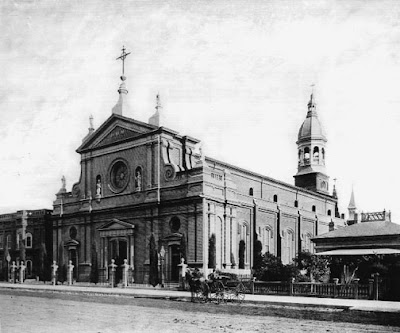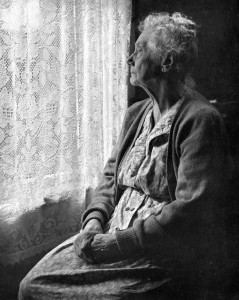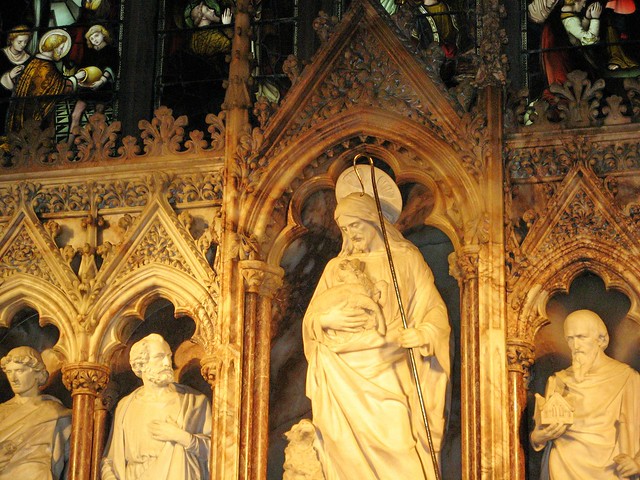By his resurrection Jesus has brought us from death to life. He has snatched us from this present evil age (Gal 1:4), and from the death directed desires of our body (Rom 6:12), and made us into a new and living creation (2 Cor 5:17). As such, we have exchanged the tombstones that once indicated we were dead in our sins, and have become living stones in the spiritual edifice which is the Body of Christ, and also the Church.
In the Epistle for today’s Mass (1 Peter 2:4-9) we are summoned to this new life and told what some of its characteristics are. Let’s take a look at how we go from being tombstones to living stones by seeing this epistle in three sections.
1. The Call of salvation – The text says: Come to him, a living stone, rejected by human beings but chosen and precious in the sight of God, and, like living stones, let yourselves be built into a spiritual house
Notice first the invitation that is made – Come to Him! Let yourself be built! The entire Christian life is based on our response to an invitation to accept Jesus Christ and to let him transform our life. We are to say, “yes” not only to Jesus, but also to what he can do for us. He will take our broken, crumbling lives and rebuild them. And in what sense will he do this?
Well look next at the images that are offered:
Living Stones – a Stone is an odd image for life. Generally we can think of nothing less living than a stone. So the text says living stones. What does it mean to be a living stone? First it means to be alive! To be full of life! Secondly it means that some of the better qualities of stone are to be ours. A stone is firm, not easily moved, weighty, and able to withstand a heavy load. And thus, we too are to be strong and firm in our faith; not easily moved about by the currents of the world, or tossed to and fro by the waves and carried about by every wind of doctrine, by human cunning, by craftiness in deceitful schemes (Eph 4:14). Stable and firm, we are also able to carry the weight and difficulties that this world imposes. And, we are able to support and carry others in their time of need. Yes, living stones: strong, firm, not easily moved and alive, quite alive!
a spiritual house – The image is that we as living stones make up, in a spiritual sense, the walls of the Church. Together we are fitted into a wall that is strong and sure. Thus, we are not saved merely unto ourselves, but we are saved also for the sake of others. Together, and by God’s grace, we depend on one another to carry our share of the weight. All the stones in a wall do their part. Remove one stone and the whole wall is weakened and threatened. Only together, with all doing their part, is the wall solid and sure.
2. The Choice for salvation – The text says, whoever believes in it shall not be put to shame. Therefore, its value is for you who have faith, but for those without faith: The stone that the builders rejected has become the cornerstone, and a stone that will make people stumble, and a rock that will make them fall. They stumble by disobeying the word, as is their destiny.
Simply put we have a choice to make and that choice will determine if Jesus is the cornerstone who supports us, or a stumbling block over whom we trip and fall. It is an interesting thing that when someone is being rescued at sea that some reach and grab the life ring that is tossed to them, others resist and fight attempts to save them, seeing it as something that will cause them further danger.
What is meant here by cornerstone? We usually think today of a ceremonial stone with an inscription and possibly some historical things inside. But the cornerstone, here, refers more to the stone at the bottom of an arch or row of bricks that supports the whole arch. It had to be a very carefully crafted stone since all the other stones depended on its integrity and perfect shape to support them. And this is Jesus Christ for us. We are all leaning on Jesus, and he is the perfect stone who carries our weight.
But for those who reject Christ, he is a stone over whom they trip and fall, a stumbling block. Surely Jesus wants to save us all, but some reject him and thus, he becomes as a stumbling block. What this means is that we cannot remain neutral about Jesus, we have to decide, one way or the other about him: Yes = salvation, no = condemnation. Thus he will either be a cornerstone or a stumbling block, there is no third way. To those who knowingly reject him, he is a stumbling block. And this image also explains some of the venomous attacks on Christ and Christianity from the world. For when one trips over something and falls, he tends to turn and curse what caused him to fall.
So the choice is ours. May it be Christ, and may he be our cornerstone, The only One on whom we lean and rely. Only this will bring us from being tombstones to living stones.
3. The Characteristics of salvation – The text says, You are “a chosen race, a royal priesthood, a holy nation, a people of his own, so that you may announce the praises” of him who called you out of darkness into his wonderful light.
Note four characteristics of those who are no longer tombstones, but are living stones:
Our Pedigree– the text calls us a “chosen race.” We reflected earlier on making Christ our choice. But here the text reminds us that before we chose him, he chose us. If we got an invitation to dinner at the White House, we would sense that we had “made it” and would proudly tell our friends of the great dignity we had received. Yet, too easily we make little notice that we are chosen by God and invited to the great Wedding Feast of the Lamb. The fact is, we are chosen, we have a pedigree. We are of the household of God. And this is a very great dignity, greater than any worldly dignity, and able to overcome any indignity that the world heaps upon us. We are a chosen race.
Our Priesthood – All of us who are baptized into Christ Jesus are made priest, prophet and king. And this “royal” priesthood, while different from the ministerial priesthood of the men who minister the sacraments, has this similarity: every priest is enabled to offer a sacrifice pleasing to God. In the old Testament, priests offered something distinct from them, usually an animal, such as a lamb. But in the priesthood of Jesus Christ, the priest and the victim are one and the same, for Jesus offered himself. Hence, all the baptized are equipped by God to offer the pleasing sacrifice of their very self to God. Herein is a very great dignity given us by Jesus: to have a perfect right to stand in his Father’s presence, praise him, and offer a fitting sacrifice. The ministerial priests of the Church bring us the sacraments, and only they can do this. But every baptized believer shares in the royal priesthood wherein they freely offer themselves to God.
Our Place – The text calls us a holy nation. The word “holy” means to be “set apart.” Hence we are called out from the many, to be a people that is set apart for God. And while all are invited to Christ, only those who accept the invitation, receive the grace to be called a holy nation. As such we should understand that our role is not to “fit in” with this sin-soaked world, but, rather, to stand apart from it, to be recognizably distinct from from it. Our behavior, our priorities, our love, our joy, and charity should be obvious to all. To be a holy nation is a great honor, but also a great responsibility. May the curse of scripture never be said about us: As it is written: “God’s name is blasphemed among the Gentiles because of you. (Rom 2:24)
Our Proclamation – the text says the Lord has acted in our life so that you may announce the praises of him, who called you out of darkness into his own, wonderful light. Yes the Lord has been good to us and is changing our life! If you are faithful, then you know what he has done for you and you have a testimony to give! Scripture says elsewhere that we were made for the praise of his glory (Eph 1:6). Do people hear you praise the Lord? Have you glorified his name among the Gentiles (Rom 15:9)? Do people know of your gratitude and have they heard of your witness to the Lord? Can you articulate how God has called you out of darkness into his marvelous light? You ought to be a witness for the Lord! This is a central and necessary characteristic of those who are no longer tombstones, but living stones.
This song points to Jesus as the cornerstone on which all of us who are living stones must lean:
And here is another old hymn that speaks of standing on Christ, the solid rock:

 One of the saddest things to experience is the closing of some of our oldest and most beautiful Catholic Churches. These older churches are some of our most magnificent in terms of architecture, theology and faith coming together. Most of these beautiful structures which are closed have succumbed to the wrecking ball. But some of them live in strange and often painful ways, becoming performing arts centers, condominiums, restaurants, and other various secular purposes.
One of the saddest things to experience is the closing of some of our oldest and most beautiful Catholic Churches. These older churches are some of our most magnificent in terms of architecture, theology and faith coming together. Most of these beautiful structures which are closed have succumbed to the wrecking ball. But some of them live in strange and often painful ways, becoming performing arts centers, condominiums, restaurants, and other various secular purposes.
 The Fourth Sunday of Easter is traditionally called Good Shepherd Sunday, for the readings focus on how our risen Lord Jesus is our shepherd who leads us to eternal life. But of course, the flip side of the Lord being our shepherd, is that we are sheep. We sometimes miss the humor of the Lord calling us sheep. The Lord could have said we were strong and swift as horses, beautiful as gazelles, or brave as lions. But, instead, he said we are like sheep. I guess I’ve been called worse, but it’s a little humbling and embarrassing really. And yet sheep are worthwhile animals and they have a certain quality that makes them pretty smart, as we shall see. Are you smarter than a sheep? Well, lets look and see how we stack up as we look at this gospel in three stages.
The Fourth Sunday of Easter is traditionally called Good Shepherd Sunday, for the readings focus on how our risen Lord Jesus is our shepherd who leads us to eternal life. But of course, the flip side of the Lord being our shepherd, is that we are sheep. We sometimes miss the humor of the Lord calling us sheep. The Lord could have said we were strong and swift as horses, beautiful as gazelles, or brave as lions. But, instead, he said we are like sheep. I guess I’ve been called worse, but it’s a little humbling and embarrassing really. And yet sheep are worthwhile animals and they have a certain quality that makes them pretty smart, as we shall see. Are you smarter than a sheep? Well, lets look and see how we stack up as we look at this gospel in three stages.